1996 BUICK PARK AVENUE air condition
[x] Cancel search: air conditionPage 132 of 388
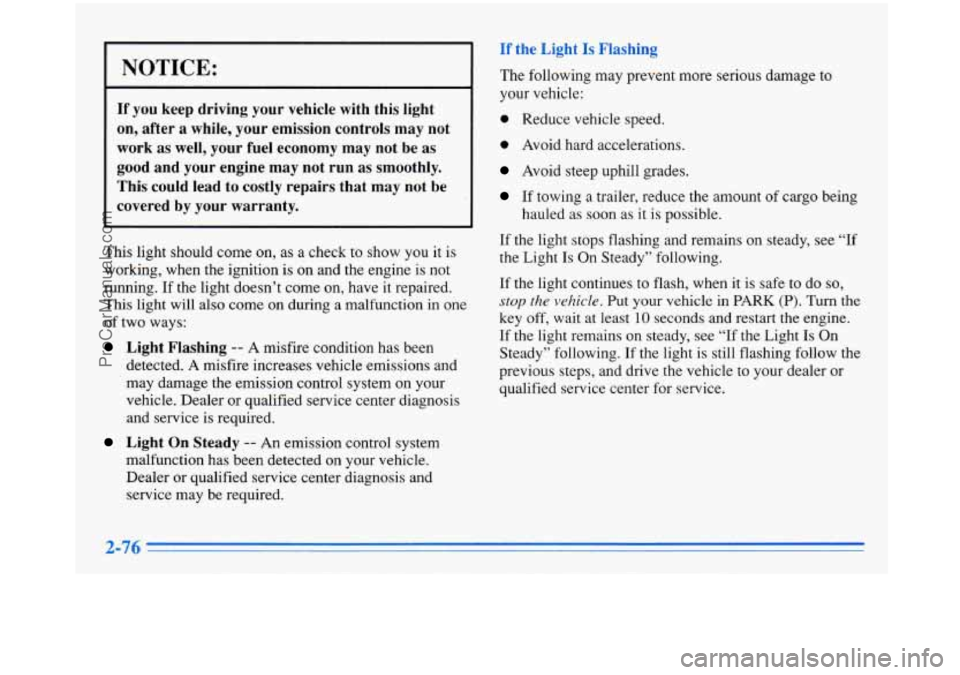
NOTICE:
If you keep driving your vehicle with this light
on, after a while, your emission controls may not
work as well, your fuel economy may not be as
good and your engine may not run as smoothly.
This could lead to costly repairs that may not be
covered
by your warranty.
This light should come on, as a check to show you it is
working, when the ignition is
on and the engine is not
running. If the light doesn’t come on, have it repaired.
This light will also come on during a malfunction in one
of two ways:
Light Flashing -- A misfire condition has been
detected. A misfire increases vehicle emissions and
may damage
the emission control system on your
vehicle. Dealer or qualified service center diagnosis
and service is required.
Light On Steady -- An emission control system
malfunction has been detected on your vehicle.
Dealer or qualified service center diagnosis and
service may be required.
If the Light Is Flashing
The following may prevent more serious damage to
your vehicle:
0 Reduce vehicle speed.
0 Avoid hard accelerations.
Avoid steep uphill grades.
If towing a trailer, reduce the amount of cargo being
If the light stops flashing and remains on steady, see
“If
the Light Is On Steady” following.
If the light continues to flash, when it is safe to do
so,
stop the vehicle. Put your vehicle in PARK (P). Turn the
key off, wait at least
10 seconds and restart the engine.
If the light remains on steady, see “If the Light Is On
Steady” following. If the light
is still flashing follow the
previous steps, and drive the vehicle to your dealer or
qualified service center for service.
hauled
as soon
as it is possible.
ProCarManuals.com
Page 133 of 388
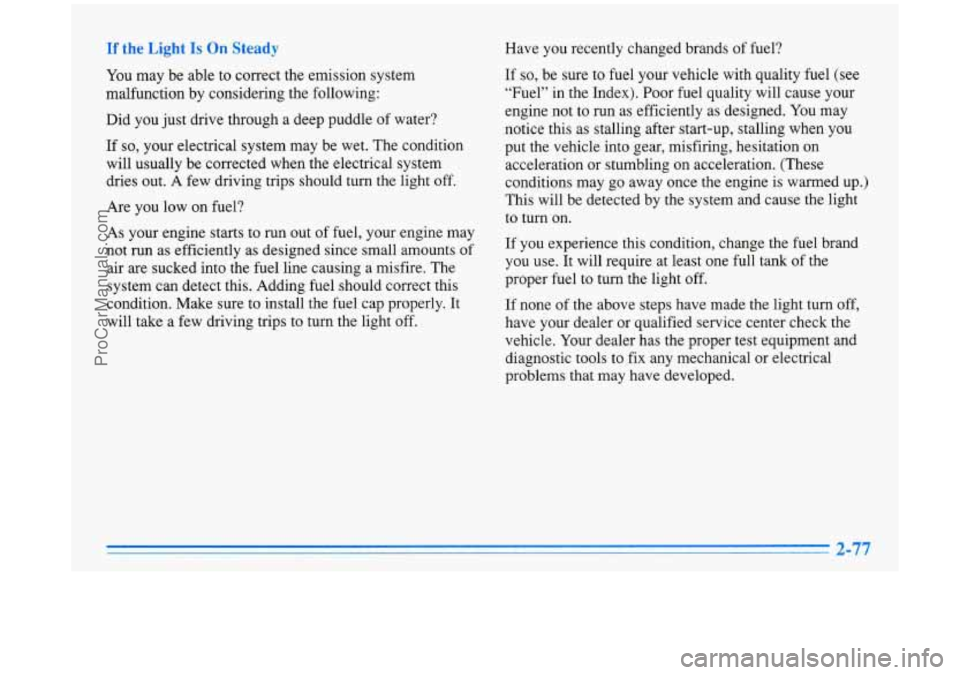
If the Light Is On Steady
You may be able to correct the emission system
malfunction by considering the following:
Did you just drive through a deep puddle of water?
If
so, your electrical system may be wet. The condition
will usually be corrected when the electrical system
dries out. A few driving trips should turn the light off.
Are you low on fuel?
As your engine starts to run out of fuel, your engine may
not run as efficiently as designed since small amounts of
air are sucked into the fuel line causing a misfire. The
system can detect this. Adding fuel should correct this
condition. Make sure to install the fuel cap properly.
It
will take a few driving trips to turn the light off. Have
you recently changed brands of fuel?
If
so, be sure to fuel your vehicle with quality fuel (see
“Fuel” in the Index). Poor fuel quality will cause your
engine not
to run as efficiently as designed. You may
notice this as stalling after start-up, stalling when. you
put the vehicle into gear, misfiring, hesitation on
acceleration or stumbling on acceleration. (These
conditions may go away once the engine is warmed up.)
This will be detected by the system and cause the light
to turn on.
If you experience this condition, change the fuel brand
you use. It will require at least one full tank of the
proper fuel to turn the light off.
If none of the above steps have made the light turn off,
have your dealer or qualified service center check the
vehicle. Your dealer has the proper test equipment and
diagnostic tools to fix any mechanical or electrical
problems that may have developed.
2-77
ProCarManuals.com
Page 142 of 388
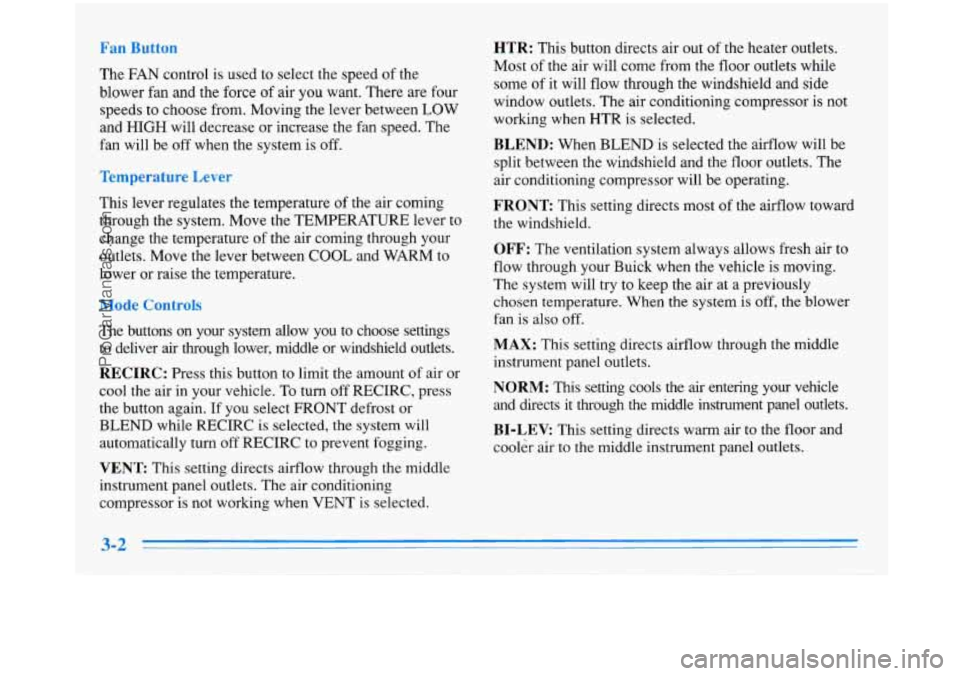
The FAN control is used to select the speed of the
blower fan and the force of air you want. There are four
speeds to choose from. Moving the lever between LOW
and
HIGH will decrease or increase the fan speed. The
fan will be off when the system is off.
This lever regulates the temperature
of the air coming
through the system. Move the TEMPERATURE lever to
change the temperature of the air coming through your
outlets. Move the lever between COOL and WARM to
lower or raise the temperature.
de Cc .-
The buttons on your system allow you to choose settings
to deliver
air through lower, middle or windshield outlets.
RECIRC: Press this button to limit the amount of air or
cool the air in your vehicle. To turn off RECIRC, press
the button again. If you select FRONT defrost or
BLEND while RECIRC is selected, the system will
automatically turn
off RECIRC to prevent fogging.
VENT This setting directs airflow through the middle
instrument panel outlets. The air conditioning
compressor
is not working when VENT is selected.
HTR: This button directs air out of the heater outlets.
Most
of the air will come from the floor outlets while
some of it will flow through the windshield and side
window outlets. The air conditioning compressor is not
working when
HTR is selected.
BLEND: When BLEND is selected the airflow will be
split between the windshield and the floor outlets. The
air conditioning compressor will be operating.
FRONT This setting directs most of the airflow toward
the windshield.
OFF: The ventilation system always allows fresh air to
flow through your Buick when the vehicle is moving.
The system will try
to keep the air at a previously
chosen temperature. When the system is
off, the blower
fan is also off.
MAX: This setting directs airflow through the middle
instrument panel outlets.
NORM: This setting cools the air entering your vehicle
and directs it through the middle instrument panel outlets.
BI-LEV: This setting directs warm air to the floor and
cooler air to the middle instrument panel outlets.
ProCarManuals.com
Page 145 of 388
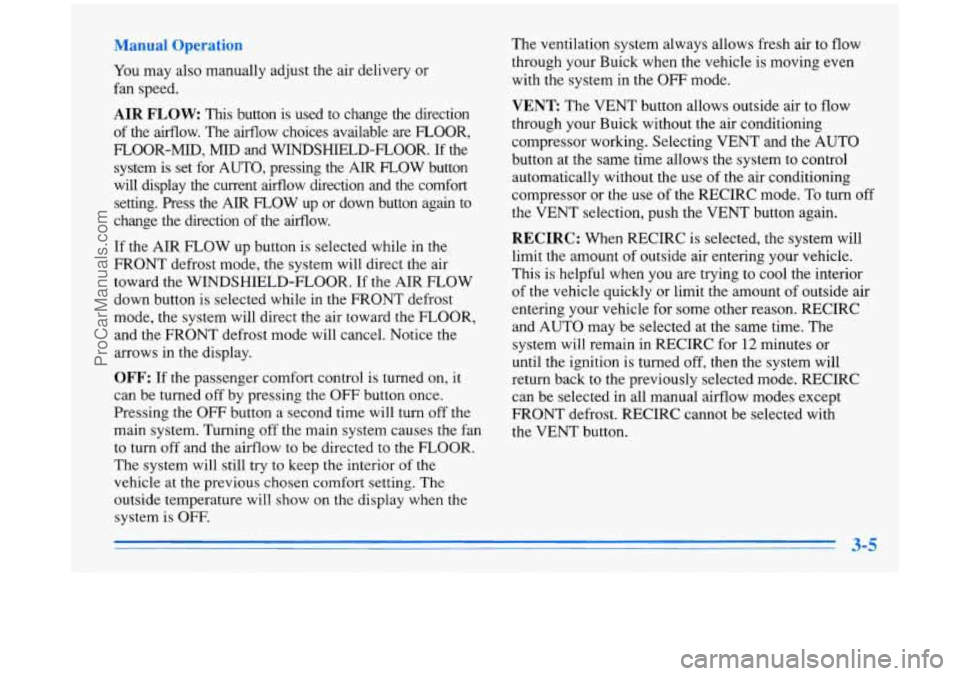
Manual Operation
You may also manually adjust the air delivery or
fan speed.
AIR FLOW: This button is used to change the direction
of the arflow. The airflow choices available are FLOOR,
FLOOR-MID,
MID and WINDSHIELD-FLOOR. If the
system is set for
AUTO, pressing the AIR FLOW button
will display the current airflow direction and the comfort
setting. Press the
AIR FLOW up or down button again to
change the direction of the airflow.
If the
AIR FLOW up button is selected while in the
FRONT defrost mode, the system will direct the air
toward the WINDSHIELD-FLOOR. If the AIR FLOW
down button is selected while in the FRONT defrost
mode, the system will direct the air toward the FLOOR,
and the FRONT defrost mode will cancel. Notice the
arrows in the display.
OFF: If the passenger comfort control is turned on, it
can be turned
off by pressing the OFF button once.
Pressing the
OFF button a second time will turn off the
main system. Turning off the main system causes the fan
to turn
off and the airflow to be directed to the FLOOR.
The system will still try to keep the interior of the
vehicle at the previous chosen comfort setting. The
outside temperature will show on the display when the
system is
OFF.
The ventilation system always allows fresh air to flow
through your Buick when the vehicle is moving even
with the system in the OFF mode.
VENT The VENT button allows outside air to flow
through your Buick without the air conditioning
compressor working. Selecting VENT and the
AUTO
button at the same time allows the system to control
automatically without the use of the air conditioning
compressor or the use of the RECIRC mode. To
turn off
the VENT selection, push the VENT button again.
RECIRC: When RECIRC is selected, the system will
limit the amount
of outside air entering your vehicle.
This
is helpful when you are trying to cool the interior
of the vehicle quickly or limit the amount of outside air
entering your vehicle for some other reason. RECIRC
and AUTO may be selected at the same time. The
system will remain in RECIRC for
12 minutes or
until the ignition is turned off, then the system will
return back to the previously selected mode. RECIRC
can be selected in all manual airflow modes except
FRONT defrost. RECIRC cannot be selected with
the VENT button.
3-5
ProCarManuals.com
Page 146 of 388
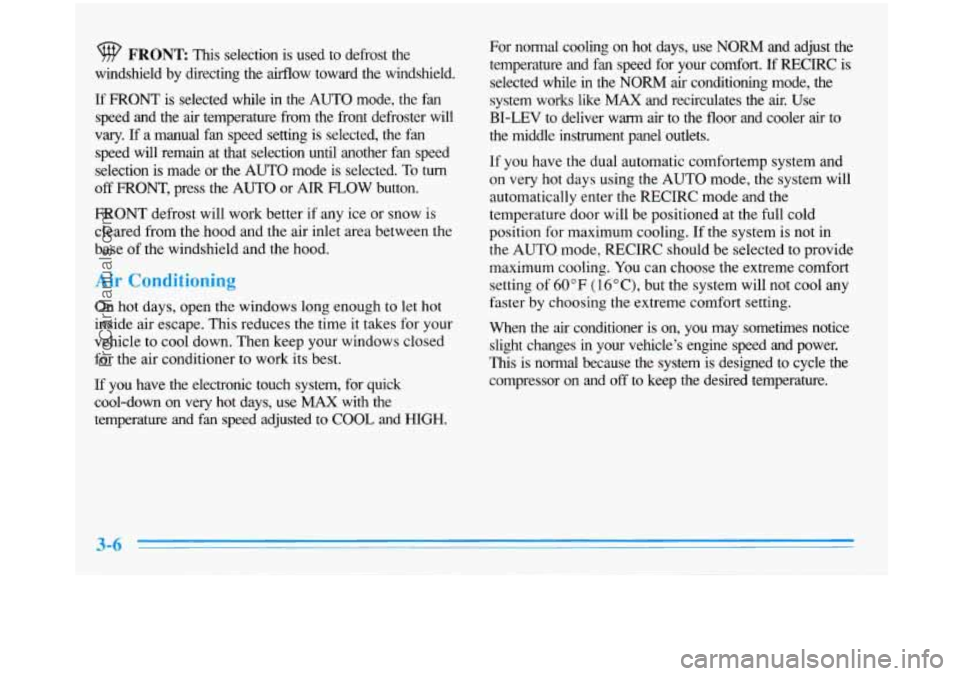
FRONT This selection is used to defrost the
windshield by directing the airflow toward the windshield.
If
FRONT is selected while in the AUTO mode, the fan
speed and the air temperature from the front defroster will
vary. If a manual
fan speed setting is selected, the fan
speed will remain at that selection until another fan speed
selection is made or the AUTO mode
is selected. To turn
off FRONT, press the AUTO or AIR FLOW button.
FRONT defrost will work better if any ice or snow is
cleared from the hood and the air inlet area between the
base
of the windshield and the hood.
Air Condi,,.
On hot days, open the windows long enough to let hot
inside air escape. This reduces the time it takes for your
vehicle to cool down. Then keep your windows closed
for the air conditioner to work its best.
If you have the electronic touch system, for quick
cool-down on very
hot days, use MAX with the
temperature and fan speed adjusted to COOL and
HIGH.
For normal cooling on hot days, use NORM and adjust the
temperature and fan speed for your comfort. If REClRC is
selected while
in the NORM air conditioning mode, the
system works like
MAX and recirculates the air. Use
BI-LEV to deliver warm air to the floor and cooler air to
the middle instrument panel outlets.
If you have the dual automatic comfortemp system and
on very hot days using the AUTO mode, the system will
automatically enter the RECIRC mode and the
temperature door will be positioned at the full cold
position for maximum cooling. If the system
is not in
the AUTO mode, RECIRC should be selected to provide
maximum cooling. You can choose the extreme comfort
setting of
60°F (16"C), but the system will not cool any
faster by choosing the extreme comfort setting.
When the air conditioner is on, you may sometimes notice
slight changes in your vehicle's engine speed and power.
This is normal because
the system is designed to cycle the
compressor on and
off to keep the desired temperature.
ProCarManuals.com
Page 188 of 388
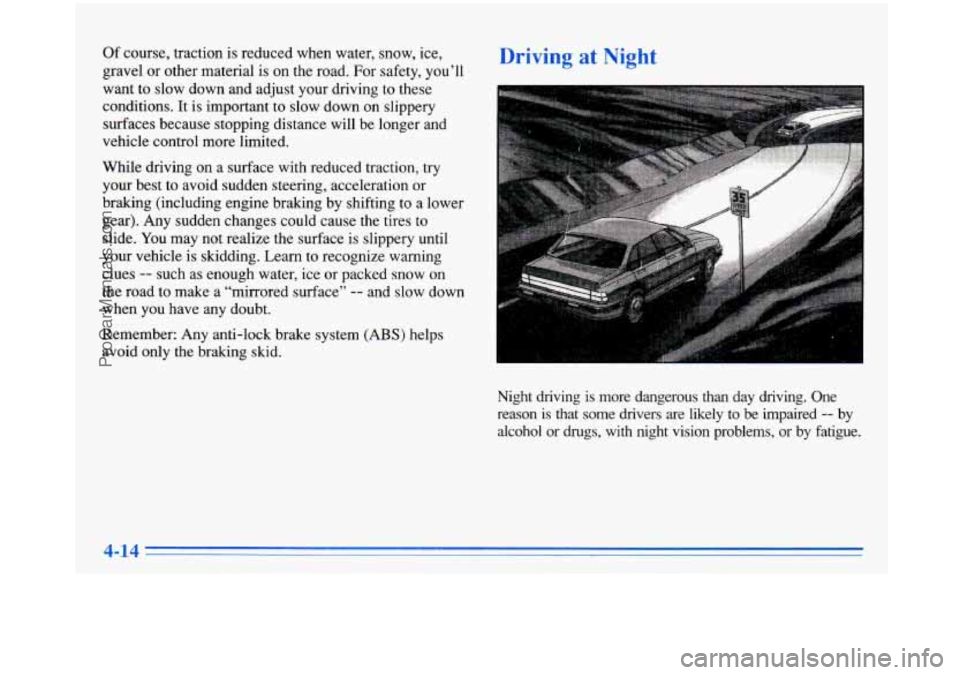
Of course, traction is reduced when water, snow, ice,
gravel or other material is on the road. For safety, you’ll
want
to slow down and adjust your driving to these
conditions.
It is important to slow down on slippery
surfaces because stopping distance will be longer and
vehicle control more limited.
While driving on a surface with reduced traction,
try
your best to avoid sudden steering, acceleration or
braking (including engine braking by shifting to a lower
gear). Any sudden changes could cause the tires to
slide.
You may not realize the surface is slippery until
your vehicle is skidding. Learn
to recognize warning
clues
-- such as enough water, ice or packed snow on
the road to make a “mirrored surface” -- and slow down
when you have any doubt.
Remember: Any anti-lock brake system (ABS) helps avoid only the braking skid.
Night driving
is more dangerous than day driving. One
reason is that some drivers are likely to be impaired
-- by
alcohol or drugs, with night vision problems, or by fatigue.
ProCarManuals.com
Page 225 of 388
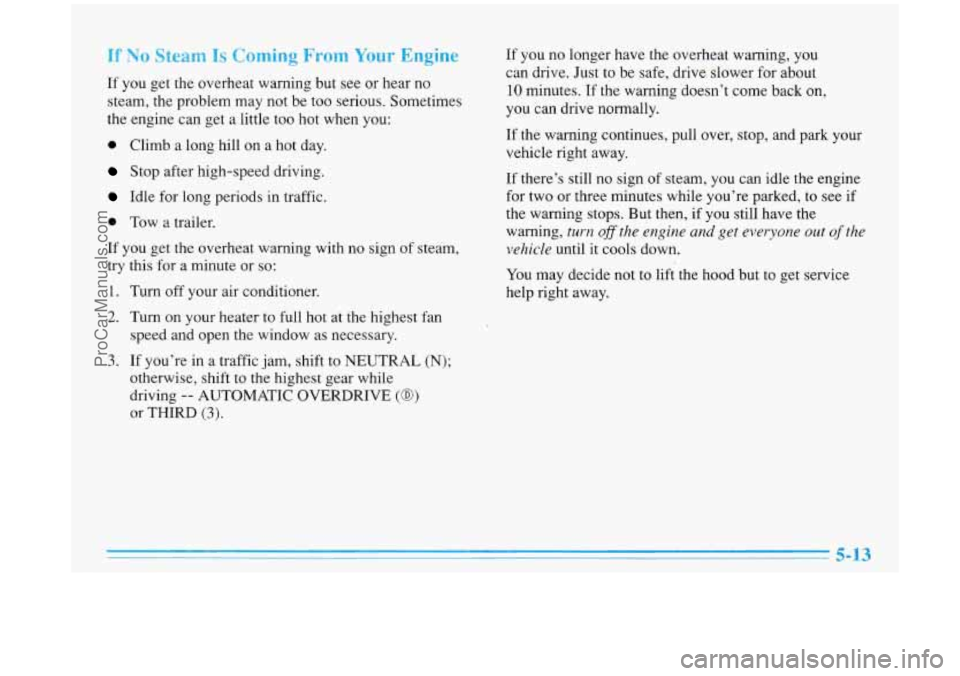
If No Steam Is Coming From Your Engine
If you get the overheat warning but see or hear no
steam, the problem may not be too serious. Sometimes
the engine can get a little
too hot when you:
0 Climb a long hill on a hot day.
Stop after high-speed driving.
Idle for long periods in traffic.
@ Tow a trailer.
If you get the overheat warning with no sign of steam,
try this for a minute or
so:
1. Turn off your air conditioner.
2. Turn on your heater to full hot at the highest fan
speed and open
the window as necessary.
3. If you’re in a traffic jam, shift to NEUTRAL (N);
otherwise, shift to the highest gear while
driving
-- AUTOMATIC OVERDRIVE (a)
or THIRD (3).
If you no longer have the overheat warning, you
can drive. Just to be safe, drive slower for about
10 minutes. If the warning doesn’t come back on,
you can drive normally.
If the warning continues, pull over, stop, and park your
vehicle right away.
If there’s still no sign of steam, you can idle the engine
for two or three minutes while you’re parked, to see if
the warning stops. But then, if you still have the
warning,
turn off the engine and get evejyone out of the
vehicle
until it cools down.
You may decide not to lift the hood but to get service
help right away.
ProCarManuals.com
Page 251 of 388
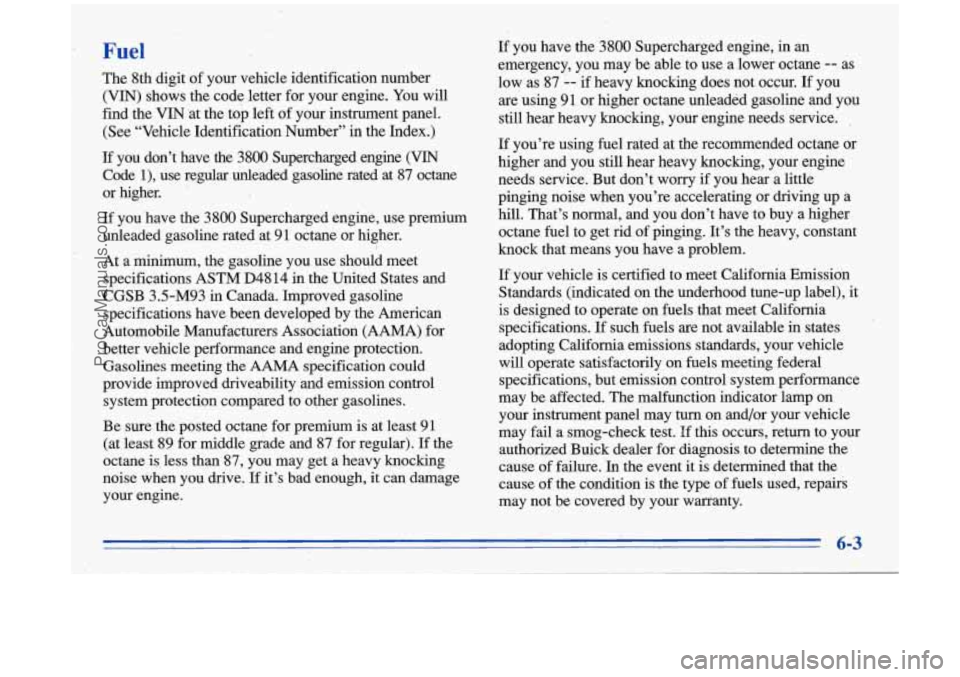
Fuel
The 8th digit of your vehicle identification number
(VIN) shows the code letter for your engine. You will
find the
VIN at the top left of your instrument panel.
(See “Vehicle Identification Number” in the Index.)
If you don’t have the 3800 Supercharged engine (VIN
Code l), use regular unleaded gasoline rated at 87 octane
or higher.
If you have the 3800 Supercharged engine, use premium
unleaded gasoline rated at 91 octane or higher.
At a minimum, the gasoline you use should meet
specifications ASTM D4814 in the United States and
CGSB 3.5-M93 in Canada. Improved gasoline
specifications have- been developed by the American
Automobile Manufacturers Association (AAMA) for
’ better vehicle performance and engine protection.
Gasolines meeting ihe AAMA specification could
, ’ provide improved driveability and emission control
system protection compared to other gasolines.
Be sure the posted octane for premium is at least 91
(at least 89 for middle grade and
87 for regular). If the
i octane is, less than 87, you may get a heavy knocking
noise when you drive.
If it’s bad enough, it can damage
your engine.
,
If you have the 3800 Supercharged engine, in an
emergency, you may be able to use .a lower octane
-- as
low as 87
-- if heavy knocking does not occur. If you
are using 91 or higher octane unleaded gasoline and you
still heq heavy knocking, your engine needs service.
,
If you’re using fuel rated at the recommended octane or
higher and you still hear heavy knocking, your engine
needs service. But don’t worry
if you hear a little
pinging noise when you’re accelerating or driving up a
hill. That’s normal, and you don’t have to buy a higher
octane fuel to get rid of pinging. It’s the heavy, constant
knock that means you have a problem.
If your vehicle is certified to meet California Emission
Standards (indicated on the underhood tune-up label), it
is designed to operate’on fuels that meet California
specifications. If such fuels are not available in states
adopting California emissions standards, your vehicle
will operate satisfactorily on fuels meeting federal
specifications, but emission control system performance
may be affected. The malfunction indicator lamp on
your instrument panel may turn on and/or your vehicle
may fail a smog-check test.
If this occurs, return to your
authorized Buick dealer for diagnosis to determine,the
cause of failure.
In the event it is determined that the
cause of the condition is the type of
fuels used, repairs
may not be covered by your warranty.
6-3
ProCarManuals.com